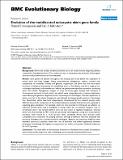Evolution of the multifaceted eukaryotic akirin gene family
Abstract
Background: Akirins are nuclear proteins that form part of an innate immune response pathway conserved in Drosophila and mice. This studies aim was to characterise the evolution of akirin gene structure and protein function in the eukaryotes. Results: akirin genes are present throughout the metazoa and arose before the separation of animal, plant and fungi lineages. Using comprehensive phylogenetic analysis, coupled with comparisons of conserved synteny and genomic organisation, we show that the intron-exon structure of metazoan akirin genes was established prior to the bilateria and that a single proto-orthologue duplicated in the vertebrates, before the gnathostome-agnathan separation, producing akirin1 and akirin2. Phylogenetic analyses of seven vertebrate gene families with members in chromosomal proximity to both akirin1 and akirin2 were compatible with a common duplication event affecting the genomic neighbourhood of the akirin proto-orthologue. A further duplication of akirins occurred in the teleost lineage and was followed by lineage-specific patterns of paralogue loss. Remarkably, akirins have been independently characterised by five research groups under different aliases and a comparison of the available literature revealed diverse functions, generally in regulating gene expression. For example, akirin was characterised in arthropods as subolesin, an important growth factor and in Drosophila as bhringi, which has an essential myogenic role. In vertebrates, akirin1 was named mighty in mice and was shown to regulate myogenesis, whereas akirin2 was characterised as FB11 in rats and promoted carcinogenesis, acting as a transcriptional repressor when bound to a 14-3-3 protein. Both vertebrate Akirins have evolved under comparably strict constraints of purifying selection, although a likelihood ratio test predicted that functional divergence has occurred between paralogues. Bayesian and maximum likelihood tests identified amino-acid positions where the rate of evolution had shifted significantly between paralogues. Interestingly, the highest scoring position was within a conserved, validated binding-site for 14-3-3 proteins. Conclusion: This work offers an evolutionary framework to facilitate future studies of eukaryotic akirins and provides insight into their multifaceted and conserved biochemical functions.
Citation
Macqueen , D J & Johnston , I A 2009 , ' Evolution of the multifaceted eukaryotic akirin gene family ' , BMC Evolutionary Biology , vol. 9 , 34 . https://doi.org/10.1186/1471-2148-9-34
Publication
BMC Evolutionary Biology
Status
Peer reviewed
ISSN
1471-2148Type
Journal article
Collections
Items in the St Andrews Research Repository are protected by copyright, with all rights reserved, unless otherwise indicated.

